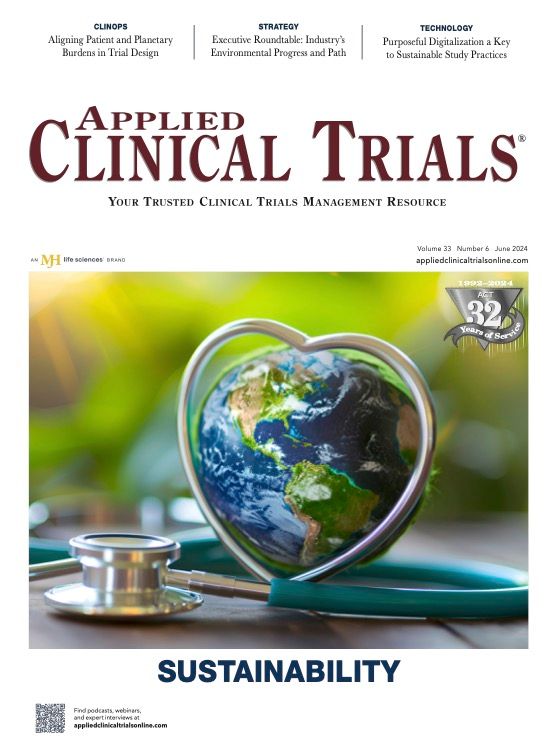In Focus: Amid Heightened Industry Rules on Sustainability, How are CROs Faring?
With investors embracing the new regulations, a look at the progress CROs are making in their sustainability efforts

A few points to review before we reach the heart of this how-green-are-they-getting look at contract research organizations (CROs) in particular.
Point one: The pharmaceutical industry, in recent years, has had no choice but to get green. Since 2018, government entities on both sides of the Atlantic have been mandating changes on how companies, in general, treat the environment. Their concern was not only about reducing emissions levels and landfill use, but also that investors should know about any risk that could ultimately affect the company’s value. In 2018, the European Union (EU) began requiring reports from companies on their sustainability performance.
The environmental, social, and governance (ESG) reports started to appear.
In the US, the Securities and Exchange Commission (SEC) formed a task force in 20211 to identify what it termed “ESG-related misconduct” by companies making claims or otherwise misrepresenting themselves to investors in ways that would impact the company’s worth. So far, the task force has found and fined a few.2
In March, the SEC sealed the deal, issuing a climate-impact disclosure rule that says companies have to publish information that details climate-related risks that could impact the company’s worth.3 The EU’s Corporate Sustainability Reporting Directive went into effect last year, which is similar to the SEC mandate.
Point two: Risk-averse investors like the regulations. A lot. Last year, sustainable funds returned 12.6% more than traditional funds, at 8.6%. Morgan Stanley called this outperformance a long-term trend.4 A look at Yahoo showed that those CROs viewed—IQVIA, PPD, Charles River Laboratories, a couple more—appear to be handling the weight of more regulation in terms of earnings and revenue. No doubt their risk ratings have something to do with it. A look at Sustainalytics, Morningstar’s ESG-risk tracker for investors, showed that the most pharma and CROs are in the low- and moderate-risk categories.
One of the lowest risk CROs is Thermo Fisher Scientific’s PPD unit, with a risk of 13, in sixth place out of 922 pharma-related industries.
“We frequently engage with our investors on the topic of sustainability and have received very positive feedback,” said Michael Cohen, MSc, MBA, senior director, lead, environmental sustainability, of the PPD clinical research business of Thermo Fisher Scientific.
Cohen says that PPD is using digitization and decentralization to make clinical trials more sustainable. “For example, we recently launched a carbon footprint calculator, which provides potential decarbonization opportunities for patient travel, virtual patient visits and digital tools for more efficient trial administration practices.”
Reducing travel is a major emissions target for the CROs. As IQVIA5 points out in its 2023 ESG report, “As a service-based company, most of our emissions are from our supply chain and business travel—[they] represent 92% of our GHG (greenhouse gas) emissions.” IQVIA says it appointed a supply chain sustainability and diversity director in 2022.
With each clinical trial, Cohen says, the PPD team asks if there are remote monitoring strategies available to reduce travel for the clinical research associates.
Travel is one target; so are supply chain inefficiencies. At Catalent,6 staff attended more than 300 Kaizen events in 2022; it says the company saved $93 million from practicing lean principles.
N-Side, a software developer specializing in forecasting and planning clinical trials, says on its website7 that trial complexities compound uncertainties, and miscalculating a trial’s actual needs can lead to waste. These complexities include biologics, temperature specifications, and specialized storage requirements for vaccines and gene therapies.
And there are patient issues that can throw calculations off, such as inaccurate recruitment figures, and unexpected additional weight—especially if the protocol calls for titrations and weight-based dispensing.
Other CROs are also making headway in their sustainability efforts. ICON plc cut its GHG emissions (for outside vendors and suppliers) from 36,726 metric tons in 2018 to 25,353 in 2022.8 Parexel calculated that it reduced its GHG emissions by avoiding air travel by 48% between 2019 and 2022.9 In 2018, Charles River10 started looking for renewable energy sources. By the end of 2019, 38% of its electricity came from renewable sources. The goal is total renewable electricity by 2030.
Of course, sustainability efforts can take other paths. At PPD, 14,000 trees—one tree per patient—have been planted at trial sites, Cohen said. “We’ve supported Amazon reforestation in Brazil, community reforestation in England, [and] tree planting in the Pacific Northwest to support orcas and salmon spawning grounds.”
Christine Bahls is a Freelance Writer for Medical, Clinical Trials, and Pharma Information
References
1. SEC Announces Enforcement Task Force Focused on Climate and ESG Issues. US SEC. March 4, 2021. https://www.sec.gov/news/press-release/2021-42
2. Enforcement Task Force Focused on Climate and ESG Issues. US SEC. April 11, 2023. https://www.sec.gov/securities-topics/enforcement-task-force-focused-climate-esg-issues
3. SEC Adopts Climate-Related Disclosure Rules. PwC. March 7, 2024. https://viewpoint.pwc.com/dt/us/en/pwc/in_briefs/2024/2024-in-brief/ib202402.html#:~:text=On%20March%206%2C%202024%2C%20the,management’s%20governance%20of%20such%20risks
4. Sustainable Funds Outperformed Peers in 2023. Morgan Stanley. Feb. 29, 2024. https://www.morganstanley.com/ideas/sustainable-funds-performance-2023-full-year
5. 2023 Environmental, Social, and Governance Report. IQVIA. https://www.iqvia.com/-/media/iqvia/pdfs/about-us/esg/iqvia-2023-esg-report.pdf
6. Corporate Social Responsibility Report. Catalent. 2023. https://cdn.catalent.com/files/cr/Catalent-Corporate-Responsibility-Report.pdf
7. Simplicity vs. Reliability in Clinical Supply Forecasting. N-Side. 2019. https://www.n-side.com/hubfs/content-lifeSciences/White-papers/N-SIDE-Whitepaper-Simplicity-vs-Reliability-in-Clinical-Supply-Forecasting.pdf
8. ICON Cares 2022 ESG Report. ICON plc. 2023. https://www2.iconplc.com/ICON_CARES_2022_ESG_Report
9. Environmental, Social, and Governance (ESG) Report. Parexel. 2023. https://newsroom.parexel.com/static-files/dca7f45f-d4f1-430d-872d-064136f8de60
10. Charles River ESG Performance Data. 2023. Charles River Laboratories. https://www.criver.com/sites/default/files/noindex/corporate/cr-esg-performance-data-2023.pdf
